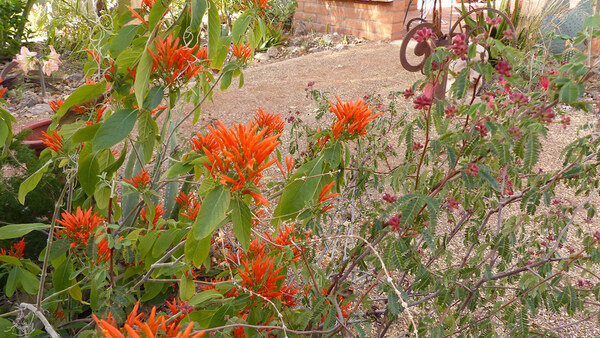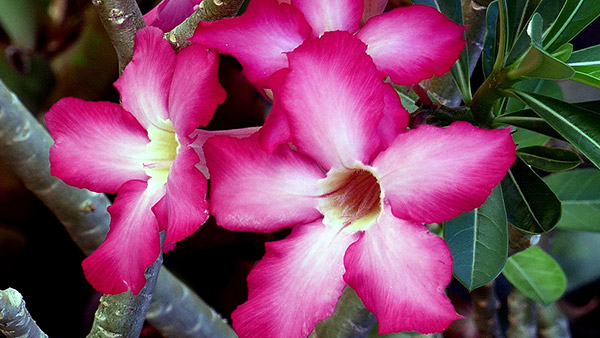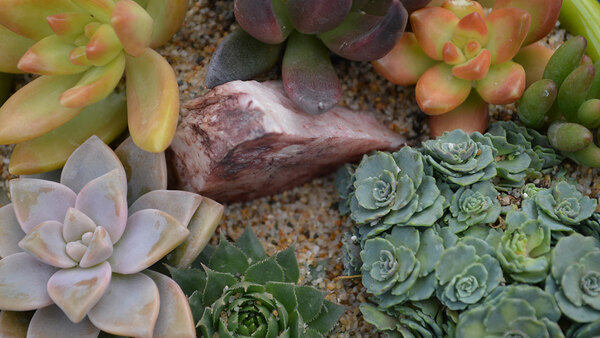
When it comes to sculptural form in the garden, it’s hard to compete with a well-grown agave (Agave spp. and cvs., Zones 7b–11). With sizes ranging from 6-inch rosettes to hulking 12-foot giants, there really is a perfect plant for every garden or container. Most are striking enough in their natural tones of green to blue, but some have raised the bar a bit higher, adding highlights of white and gold to the palette.
Variegation usually appears as a chance mutation among seedlings, or occasionally in new pups or even tissue-cultured plants. How this develops as plants mature can vary a lot, but in monocots like agaves the chlorophyll will usually be reduced in linear patterns along the edges or down the center of the leaves, and sometimes with irregular variations between the surface and deeper leaf tissue. These effects can be striking—and rare, resulting in some astonishing prices. However, some forms have been around for decades and are passed along at reasonable cost with little fanfare, but they are no less useful in the landscape. Here are a few of my favorite variegated agaves that suit a variety of conditions and always add a unique highlight to the garden.
Agaves at a glance
A few basic requirements are shared by all members of this genus.
- Good drainage (and allow to dry out between waterings)
- Full to partial sun
- Enough room to reach their expected mature size
- Varied cold tolerance between species
Century agave
(Agave americana var. marginata)
Zones: 8–11b
Size: Up to 10 feet tall and 12 feet wide (less in containers)
The leaves on young plants are mostly straight but can develop sinuous curves as the plants mature. This is a spectacular specimen in a location with backlighting. Expect century agave to freely produce pups (young offset plants).
‘Arizona Star’ Weber agave
(Agave weberi ‘Arizona Star’)
Zones: 8b–10b
Size: Up to 5 feet tall and 8 feet wide
This is a “friendly” agave with unarmed leaf edges, which is unusual for such a large species. This is another amazing specimen in a location with backlighting. You can count on it producing a moderate number of pups.
‘Orca’ whale tongue agave
(Agave ovatifolia ‘Orca’)
Zones: 7b–10
Size: Up to 3 feet tall and 6 feet wide
Wide blue leaves with striking creamy yellow margins form robust, stout rosettes on this plant. Of moderate height, it nevertheless is an incredible focal point in a succulent garden. A drawback is that it very rarely produces any pups.
‘Ivory Curls’ gypsum agave
(Agave gypsophila ‘Ivory Curls’)
Zones: 9b–11 (needs protection from frost)
Size: Up to 3 feet tall and wide
Noted for its ghostly blue-green leaves accentuated with undulating cream margins, “Ivory Curls’ looks particularly good in a container. Over time it will produce pups nearby.
‘Crème Brulee’ agave
(Agave guiengola ‘Crème Brulee’)
Zones: 9–11
Size: Up to 3 feet tall and 4 feet wide
These leaves are broad and are fewer in number than those of most agave species, creating an open starfish effect. The cream to yellow margins can occasionally have pink tones as well, with small dark teeth. This agave pups easily.
‘Quadricolor’ agave
(Agave lophantha ‘Quadricolor’)
Zones: 8–10b
Size: 18 inches wide and 24 inches tall
Toothy bright gold edges contrast with grass green on these leaves, with a lighter stripe down each center. This species is striking in containers and pups abundantly.
Queen Victoria agaves
(Agave victoria-reginae cvs.)
Zones: 9–10b
Size: Up to 12 inches tall and 14 inches wide (very slow growing)
There are many variegated forms of Queen Victoria agave, both gold and white, with some quite rare and prized by collectors. ‘White Rhino’ seems to be the current “holy grail.” The plants all form dense and sturdy mounds with a wonderful geometric form. This species is slow to mature but produces pups freely, especially when confined to tight containers.
‘Sunspot’ agave
(Agave parryi subsp. neomexicana ‘Sunspot’)
Zones: 5b–10b
Size: Up to 12 inches tall and 24 inches wide
This is the hardiest variegated agave for chillier zones. Its cream margins (most pronounced in strong sun) with black teeth and terminal spines are striking in rock gardens and colder desert landscapes. Pups appear at a moderate rate. Good drainage is essential.
Butterfly agave
(Agave potatorum and cvs.)
Zones: 9–11a (protect from frost)
Size: 14 inches tall and 16 inches wide
Many forms of butterfly agave exist and are prized by collectors. ‘Kissho Kan’ (pictured) is compact and highly textured, with scalloped leaf margins highlighted in cream/gold and edged with reddish teeth. Any butterfly agave is a perfect container specimen that will produce pups readily.
Learn more:
For more Southwest regional reports, go here.
Dan Johnson lives and gardens in Denver and in Tucson, Arizona. He is an associate director of horticulture for the Denver Botanic Gardens.
Photos: Dan Johnson



























Comments
Log in or create an account to post a comment.
Sign up Log in